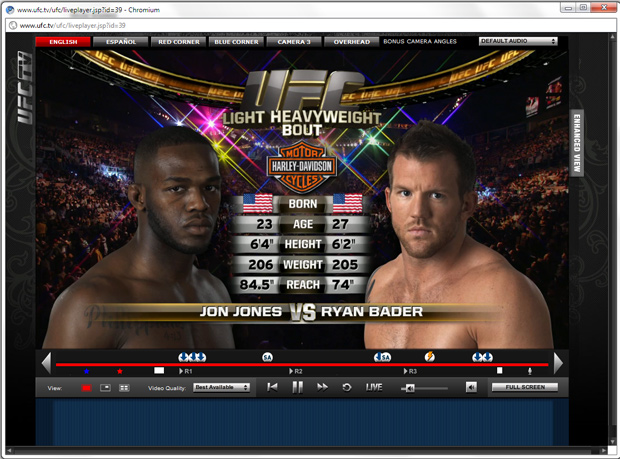
NeuLion announced a deal a few days ago to bring “a brand new service for UFC offering the most interactive, far-reaching digital experience yet.” Last night’s UFC 126 was the first pay-per-view event to receive the NeuLion treatment, so I decided to check it out to see what all the fuss was about. Fair warning: There will be spoliers.
First, who’s NeuLion? The company describes itself as “a leading IPTV company providing a comprehensive suite of technology and services to content owners and aggregators.” Its partners include MLS, the NHL, the NBA, Bellator Fighting Championships, and now UFC, which is by far the biggest mixed martial arts promotion in the world. Non-sport clients include Dish Network and several international organizations I’m not too familiar with, including Latin America’s JumpTV and Scandinavia’s ScandiTV.
UFC 126, broadcast live from Las Vegas, featured Anderson Silva front-kicking Vitor Belfort into next Tuesday, fast-rising sensation Jon “Bones” Jones guillotining Ryan Bader, who’s an altogether excellent wrestler, and the UFC debut of Norifumi “Kid” Yamamoto, Japan’s most famous mixed martial artist—excepting Kazushi Sakuraba, of course. Too bad he lost.

What do you get for your $44.95? (Fun fact: The event was free on ufc.tv in Germany and Austria. Gotta build that audience somehow: UFC was thrown off the air in Germany about a year ago.) Naturally there’s a high-quality Flash livestream—there was a noticeable bump in quality once Jones vs. Bader began—but that’s always been available on previous official UFC streams; it’s nothing to brag about. That the steam jumped around in bitrate was annoying but to be expected. (I should think my Internet connection, with 101 mbps down, can handle a mere Flash stream!) The NeuLion-ness begins with the ability to choose from multiple camera angles: the standard broadcast camera, cameras from each fighter’s corner, and an overhead camera. These disparate camera angles can be viewed simultaneously in a “quad view” mode. Similarly, there’s a picture-in-picture mode that allows you to hover a secondary camera angle window on top of your primary camera angle window, which remains at full-size. English and Spanish-language audio feeds are available, as well as each fighter’s corner’s audio feed. If you, like me, studied Portuguese in college for seemingly no reason then you could have listened to Anderson Silva’s corner bark orders at him for the duration of the fight. Well, the duration of the round.
Good, clean fun, but I think I’m correct in noting that Strikeforce launched a multi camera angle online stream last year, too.
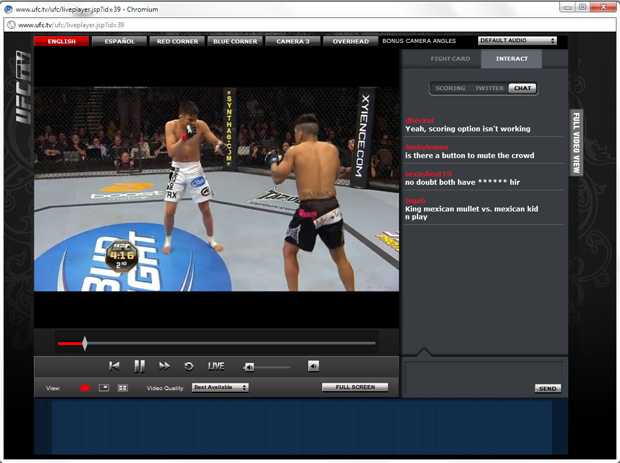
On the right-hand side lies an “enhanced view,” which contains a live chatroom where you can talk to other folks about the on-screen action. Fans can also score rounds in this panel. Will you, unlike pretty much every judge out there, be brave enough to give a round a 10-8 score, or perhaps the even rarer 10-10?
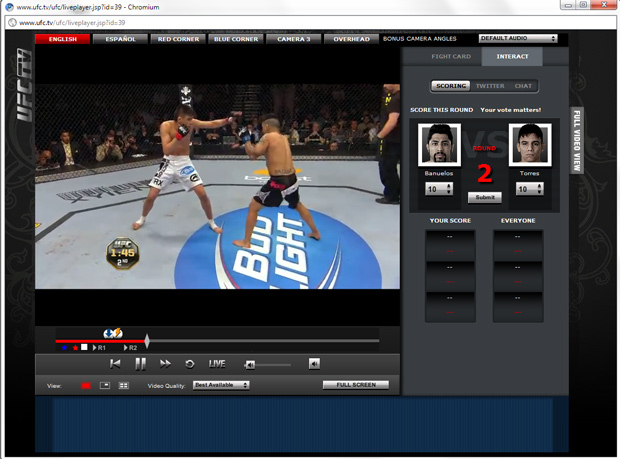
A built-in Twitter panel follows the #UFC and #UFC126 hashtags.
Now the question on everyone’s mind: is this better than a traditional pay-per-view that you’d buy from your cable or satellite TV provider? I’m going to say no, it’s not, but it’s getting there.
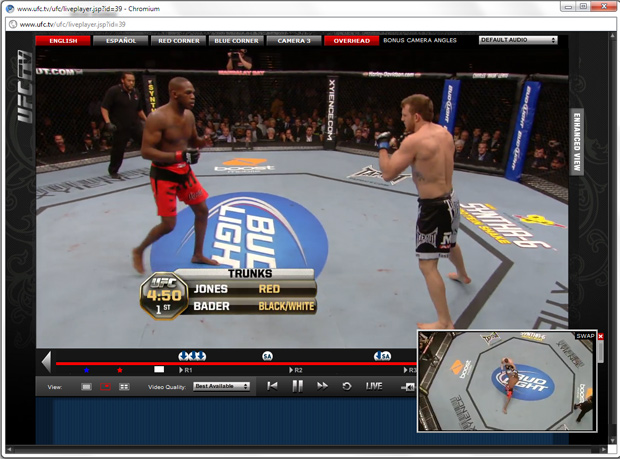
First off, I can’t imagine too many people will want to huddle around a laptop to watch a sports event, though I suppose you could connect your computer to your TV and watch it that way. I’d imagine the number of people who know how to day that, much less are willing to do that, is effectively zero. UFC tends to be a communal viewing experience: you invite your friends over, order a couple of pizzas, the whole nine yards. You stand to lose that here. For $10 more I could have ordered the HD version of the event from DirecTV and watched it on my 50-inch TV.
That said, I did enjoy the experience. The livestream was of a high enough quality that I didn’t feel like I was watching a YouTube video in 2006 (or an illegal stream), and the same can be said of the audio quality: top-notch. It’s not Dolby Digital, but what are you gonna do? The multiple camera angles certainly added the the whole experience—I believe “immersion” would be the word to use—but I often found myself sticking with the standard broadcast camera. The chat room was largely No Buys (read: lame), but that’s to be expected: people in live sports chatrooms tend to be rather prickly. “So-and-so sucks” and so forth. Stop trying to get yourselves over, sirs.
It should also be said that if usage-based billing were to ever make its way to the U.S. this service would wither and die. (And you need more evidence why cable companies would love to charge by the gigabyte? It makes things like Internet pay-per-view streams prohibitively expensive, pushing people back to plain ol’ pay-per-view where they get a nice cut of the action, sharing that revenue with the likes of UFC and WWE.)
My biggest concern is price: $45 is simply too much money to ask for a livestream of sometimes dubious quality, particularly when a proper HD pay-per-view from the cable company (in my case, DirecTV) is a mere $10 more. As much as people like to hate on Comcast and Time Warner and the like, the fact is your HD pay-per-view isn’t going to “buffer” at inopportune times. Until all of the kinks have been worked out, UFC would do well to experiment with their stream prices. The card last night was one of the deepest in history, so $45 doesn’t sting as much as it would have stung for, say, last September’s UFC 119. Why not price some of the “B” events at closer to $30 and make them impulse buys?
Then again, UFC fans tend to be among the most affluent in all of sports, so maybe Dana White & Co. are right to charge whatever they want.
Another annoyance is the fact that you’re only given a 24-hour window to watch the event. That’s in direct contrast to Dragon Gate USA and Ring of Honor Internet pay-per-vew (iPPV) events found on GoFightLive.tv. There, you buy the event (typically $15) and can watch it on-demand forever, usually beginning the very next day.
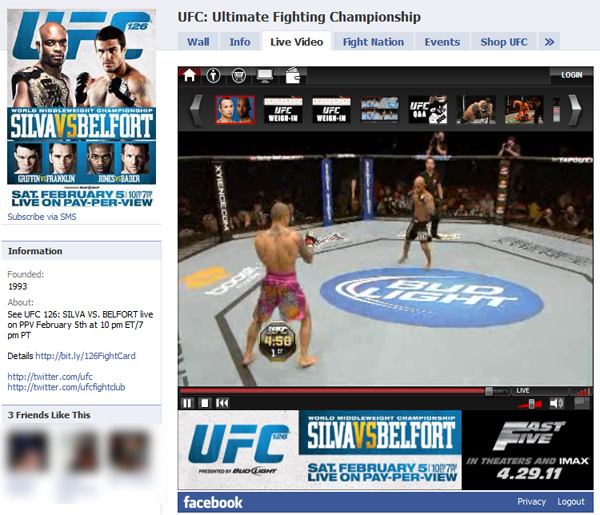
If nothing else, UFC should be commend for trying to bring its product into the Internet era. While it’s true that the company is suing everyone under the Sun in an effort to eliminate illegal Internet streams—a difficult task at best—at least it’s offering viable alternatives to would-be customers. (Kid Yamamoto’s fight aired on the company’s Facebook page for free, as seen in the above grab.) The RIAA used to sue everyone, too, but it never really offered a legal alternative to sate the obvious demand for digital downloads. No, Apple had to drag the music industry kicking and screaming for that to happen.